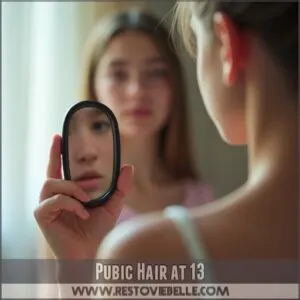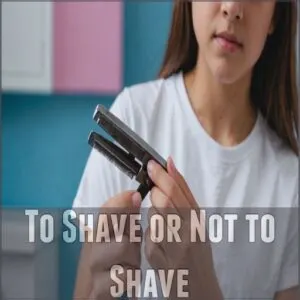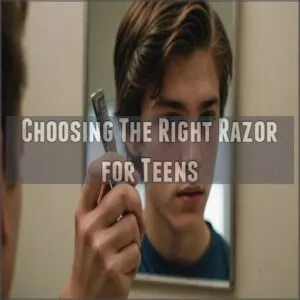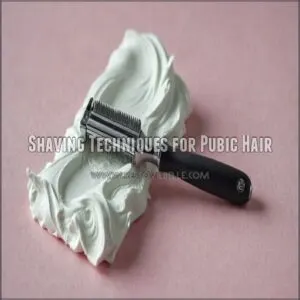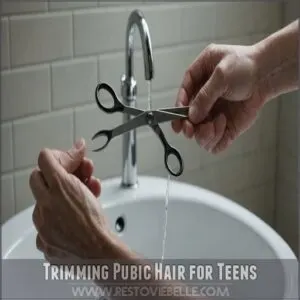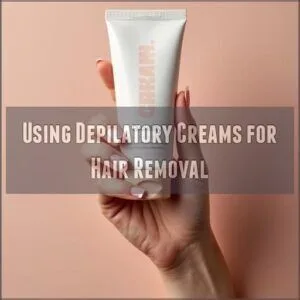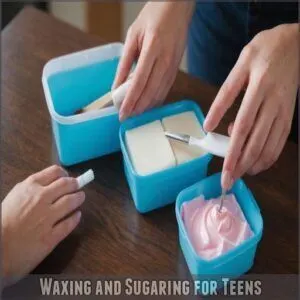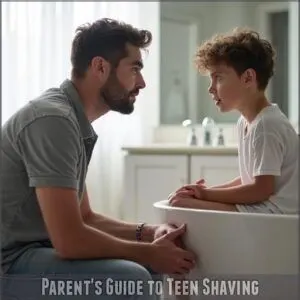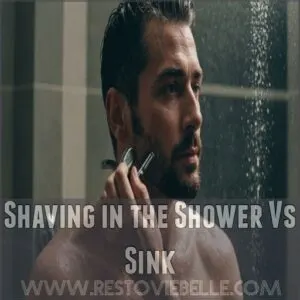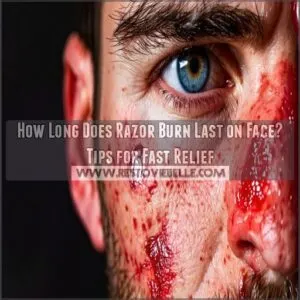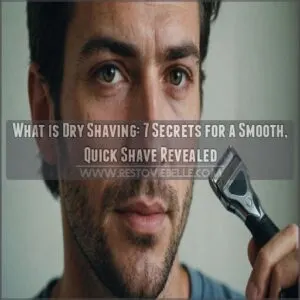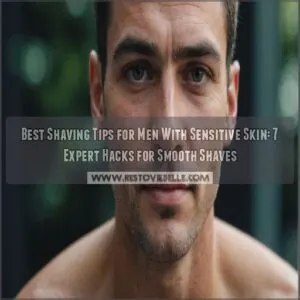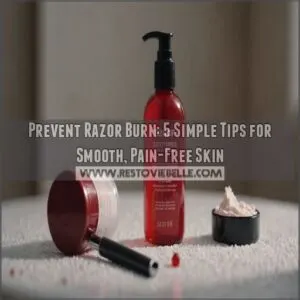This site is supported by our readers. We may earn a commission, at no cost to you, if you purchase through links.
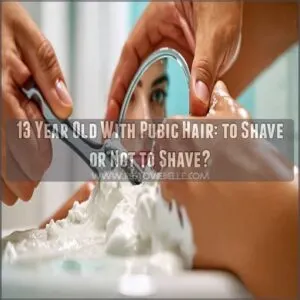 Whether you should shave your pubic hair at 13 is entirely your choice – there’s no medical reason to do it.
Whether you should shave your pubic hair at 13 is entirely your choice – there’s no medical reason to do it.
Pubic hair is completely natural and serves important functions like preventing friction and protecting sensitive areas.
If you’re curious about removing it, know that shaving isn’t your only option.
Whatever you decide, it’s important to use proper hygiene and safe techniques to avoid irritation or infection.
Talk to a trusted adult who can guide you through this personal decision and help you understand the pros and cons of different hair removal methods.
Armed with the right knowledge, you’ll feel more confident about your body care choices.
Table Of Contents
- Key Takeaways
- Pubic Hair at 13
- To Shave or Not to Shave
- Shaving Safely at 13
- Alternatives to Shaving
- Parent’s Guide to Teen Shaving
- Frequently Asked Questions (FAQs)
- Is it normal for a 13 year old to have pubic hair?
- At what age should a girl start shaving down there?
- How to shave your pubic area for 13 year olds?
- How do you get rid of pubic hair for a 13 year old?
- How often should teens clean and replace razors?
- What products work best for sensitive teenage skin?
- When should teens seek medical help for irritation?
- How to handle pressure from friends about shaving?
- What areas are safe versus risky to shave?
- Conclusion
Key Takeaways
- Pubic hair at 13 is completely normal—it’s a natural part of growing up and developing secondary sex characteristics.
- Shaving pubic hair comes with risks, such as razor burn and ingrown hairs, and some may prefer alternatives like hair removal creams, which offer a painless hair removal solution, so consider safer options, like trimming or using hair removal creams.
- When deciding to shave, talk to a trusted adult who can guide you on proper techniques and hygiene to stay safe and comfortable.
- Ultimately, the choice to remove or keep your pubic hair is personal—do what feels best for you and don’t let peer pressure influence your decision.
Pubic Hair at 13
Puberty is a wild ride, isn’t it? If you’re noticing peach fuzz around your most intimate areas, don’t freak out – it’s totally normal for a 13-year-old.
Is It Normal to Have Pubic Hair?
Yes, it’s completely normal to have pubic hair at 13. This hair often starts growing during puberty, a natural process of physical changes that everyone goes through.
Don’t worry – it’s just your body’s way of maturing. You may notice some differences in the amount of hair compared to friends, but that’s OK too.
Embrace the changes and be patient with yourself during this time.
Why Do Girls Grow Pubic Hair at 13?
Pubic hair growth at 13 is a normal part of puberty.
As hormone levels change, your body starts developing secondary sex characteristics, including pubic hair.
This change can feel awkward, but it’s simply your body maturing.
Try not to stress – pubic hair is a natural part of growing up.
It’s also a good idea to discuss shaving and its risks with a trusted adult to make an informed decision.
| Onset | Location | Purpose |
|---|---|---|
| Ages 8-13 | Genital Area | Development of Secondary Sex Characteristics |
| Triggered by Hormones | Underarms, Legs, Face (Boys) | Signals Physical Maturity |
| Gradual Process | Coarse, Curly Hair | Protects Sensitive Areas |
How to Deal With Pubic Hair Growth
It’s totally normal for girls to sprout pubic hair at 13, but dealing with it can feel awkward.
The good news? You’ve got options.
Trimming with scissors is a simple solution that keeps things neat without irritating skin.
Chat with parents or a doctor if you have questions – they’ve been there and can offer advice.
To Shave or Not to Shave
To shave or not to shave – that’s the big question when pubic hair appears at age 13, isn’t it?
Sure, shaving can give you a neat and tidy look, but there are some health risks to think about as well.
Let’s take a closer look and explore the pros and cons, so you can decide what feels best for you.
Pros and Cons of Shaving at 13
Considering shaving at 13 has its pros and cons.
On the plus side, it can boost confidence and help you feel more mature.
To minimize these risks, shaving with the grain and using lubricants can help reduce irritation, as explained in how to stop itching. But shaving pubic hair can cause skin irritation, ingrown hairs, and even infections if not done properly.
Chat with your parents about the best approach for your comfort and safety.
Health Risks Associated With Shaving
Shaving can sometimes cause unpleasant skin irritation, like razor burn, ingrown hairs, or even folliculitis.
For persistent ingrown hairs, consider using products specifically designed for ingrown hair removal.
To avoid these issues, use a sharp, high-quality razor and shave gently with the grain.
Go, especially around sensitive areas, and stop if you notice any nicks, cuts, or excessive redness.
Your skin will thank you!
Parental Guidance on Shaving
How can parents guide their teens through understanding the importance of considering regrowth level and personal comfort when deciding to shave pubic hair, as shaving every 2-3 days can maintain a clean look, but may not be suitable for everyone, especially when considering frequent shaving routines. How can parents guide their teens through the decision to shave pubic hair? Here are a few tips:
- Have open conversations about hygiene, self-confidence, and personal choice.
- Offer to help demonstrate proper shaving techniques to avoid irritation.
- Encourage your teen to make informed decisions that align with their values.
- Remind them that pubic hair is natural and there’s no obligation to remove it.
Shaving Safely at 13
Ready to tame that teenage ‘stache?
We’ve got your back!
Discover the right razors, shaving techniques, and consider proper shaving direction to keep your skin smooth and bump-free.
Trust us, it’s easier than it seems.
Choosing The Right Razor for Teens
Choosing the right razor as a teen can be tricky, but it’s important for safe, comfortable shaving.
Consider your skin type, especially if it’s prone to issues like razor bumps read about sensitive skin shaving. – opt for a single-blade razor if you have sensitive skin.
Electric razors offer an extra layer of protection for newbies.
And remember: keep your razor clean and replace it regularly to avoid irritation.
| Razor Type | Sensitivity | Recommended For |
|---|---|---|
| Single-Blade | Sensitive | Beginners & Sensitive Skin |
| Multi-Blade | Normal | General Use |
| Electric | Very Sensitive | Acne-Prone or Irritated Skin |
Shaving Techniques for Pubic Hair
Regarding shaving pubic hair, take your time and go with the grain.
Wet the area thoroughly, apply a suitable sensitive skin shaving cream, and use short, gentle strokes in the direction of hair growth.
Take extra care around tricky spots to avoid painful nicks.
With a little practice, you’ll be shaving like a pro.
Avoiding Ingrown Hairs and Irritation
Though shaving can cause irritation and ingrown hairs, proper techniques can prevent these issues.
Exfoliate regularly to remove dead skin and allow hair to grow out properly.
Use a sharp, high-quality razor and shave in the direction of hair growth.
Moisturize after shaving to soothe the skin.
Using gentle shaving techniques and a quality razor, such as those found in the best razor for black men, can greatly reduce irritation. With a little care, you can avoid the discomfort of razor burn and ingrown hairs.
Alternatives to Shaving
If you’re not ready to pick up a razor, you’ve got plenty of other options for managing pubic hair that might work better for you.
From simple trimming to gentle hair removal creams, let’s look at some safer alternatives that won’t leave you dealing with razor burn or painful cuts.
Trimming Pubic Hair for Teens
Trimming offers a gentler approach than shaving for managing pubic hair growth.
It’s like giving your lawn a quick trim instead of pulling everything out by the roots.
You’ll want to follow these key steps for safe trimming:
- Use dedicated scissors with rounded tips
- Trim in good lighting over a toilet or shower
- Start longer than you think – you can always trim more
Just remember: there’s no rush, and less is often more.
Using Depilatory Creams for Hair Removal
Depilatory creams offer a gentler alternative to razors, dissolving hair right at the skin’s surface.
You’ll want to do a patch test first since these creams can be harsh on sensitive areas.
Remember to choose products specifically made for the bikini area and follow instructions carefully.
While they’re easy to use, the results typically last just a few days longer than shaving.
Never use them on broken or irritated skin.
Waxing and Sugaring for Teens
Waxing and sugaring offer longer-lasting results than creams, but they’re not for everyone, especially teens with sensitive skin.
You can also consider using teen waxing kits, like those available at home waxing kits for teens, which can be more convenient and private.
While these methods can keep hair away for weeks, they do involve some discomfort.
If you’re thinking about trying either option, start with a patch test and consider having it done by a professional who specializes in teen services. They’ll know the right techniques and temperature settings for young skin.
Parent’s Guide to Teen Shaving
You’ll want to handle the "shaving talk" with your teen just as carefully as other sensitive topics like dating and social media use.
As a parent, you can help your teen navigate this personal choice by sharing clear information about safety, hygiene, and the perfectly normal range of options available to them.
When to Allow Your Teen to Shave
Deciding when your teen can start shaving isn’t about age – it’s about readiness and maturity.
Watch for signs they’re self-conscious about body hair or asking questions about hair removal.
Some teens might be ready at 12, while others won’t show interest until 15.
You’ll know they’re ready when they can follow safety instructions and understand proper hygiene practices.
Trust your parental instincts here.
How to Talk to Your Teen About Shaving
Starting an open conversation about shaving isn’t always easy, but it’s important for your teen’s well-being.
Consider using "I" statements to express feelings and preferences, like when discussing boyfriend to shave.
Choose a relaxed moment when you’re both comfortable, like during a car ride or while making dinner.
Listen more than you talk, and validate their feelings about body image and peer pressure.
Share your own experiences, keeping it real and judgment-free.
Remember, this chat builds trust and understanding.
Setting Boundaries and Rules for Shaving
Everyone needs clear guidelines regarding teen shaving.
Set boundaries that respect both safety and your teen’s growing independence.
Work together to create rules that make sense for your family, focusing on hygiene and responsible razor use.
- Keep razors in a designated spot – no wandering blades around the house
- Establish a routine for replacing disposable razors
- Create a shower schedule that respects privacy
- Agree on when and where shaving is appropriate
Frequently Asked Questions (FAQs)
Is it normal for a 13 year old to have pubic hair?
You bet it’s normal!
Most teens sprout some ‘down there’ hair by age
It’s just part of growing up, friend.
No need to feel self-conscious – this hair is a perfectly natural sign of puberty.
At what age should a girl start shaving down there?
There’s no set age when you should start shaving.
The timing really depends on your personal preferences and comfort level.
If you’re interested, chat with a parent or doctor about the best approach for you.
How to shave your pubic area for 13 year olds?
Start by trimming with scissors.
Then use a clean, sharp razor and some shaving cream.
Take it slow, be gentle, and don’t worry – you’ll get the hang of it with a little practice.
How do you get rid of pubic hair for a 13 year old?
Are you wondering how to get rid of pubic hair?
Understand your options – shaving, trimming, or even leaving it be.
The choice is yours, and what matters most is what feels comfortable for you.
How often should teens clean and replace razors?
Replace disposable razors every 4-5 uses to avoid nicks and cuts.
Clean your razor after each use to prevent rust and bacteria buildup.
Take your time and shave gently, in the direction of hair growth.
What products work best for sensitive teenage skin?
Opt for gentle, fragrance-free cleansers and moisturizers designed for teen skin.
Steer clear of harsh scrubs or retinol products, which can irritate sensitive complexions.
Consider using an alcohol-free toner to balance oil without stripping your skin.
When should teens seek medical help for irritation?
If skin irritation persists or worsens after shaving, don’t hesitate to consult your doctor.
They can recommend soothing products and determine if any underlying conditions require treatment.
Your comfort is the priority.
How to handle pressure from friends about shaving?
Dealing with peer pressure about shaving can be tough, but remember – it’s your choice.
Be confident in yourself and don’t feel obligated to do anything you’re not comfortable with.
If your friends don’t respect that, maybe it’s time to find new ones.
What areas are safe versus risky to shave?
Generally, it’s safest to stick to shaving visible areas like your legs and underarms.
The pubic region has sensitive skin, so it’s best to consult a doctor before attempting to shave that area on your own.
Conclusion
Well, there’s no one-size-fits-all answer to whether a 13-year-old should shave their pubic hair.
It’s a personal choice that depends on your comfort level and hygiene needs.
If you do decide to shave, take it slow, and consult a trusted adult to guarantee your safety.
At the end of the day, remember – your body, your decision. Own it, and rock it with confidence!
